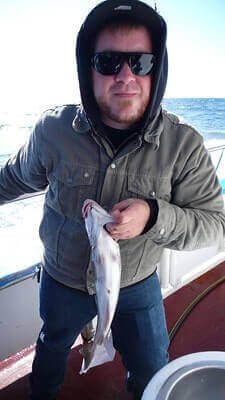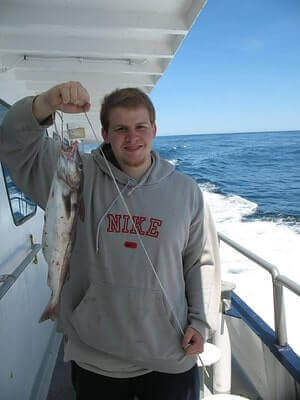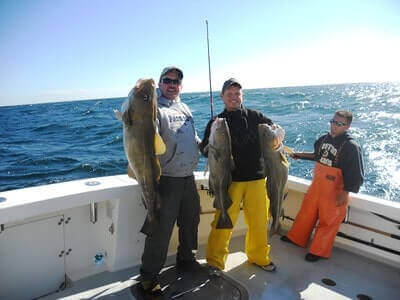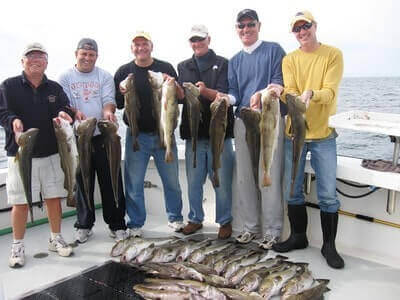Disclosure: We may earn commissions if you purchase products after clicking on a link from our site.
Do you want to learn how to catch haddock? Haddock is a member of the cod family. It can be found in the North Atlantic Ocean, the Gulf of Maine, and northern Europe. Haddock is a bottom feeder and finding areas and structures that may serve as a cover for haddock is important to successfully catch this fish. In this article, we share information on fishing techniques, tips, and equipment to help you catch more haddock.

Table of Contents
How To Catch Haddock
1. Drift Fishing
Drifting involves allowing the boat to drift naturally with the current while presenting baits or lures to haddock below. Anglers may drift over known haddock habitats such as rocky outcrops, shoals, or wrecks, presenting baits or lures at various depths to entice strikes.
Drifting allows anglers to cover large areas of water while presenting baits or lures naturally and enticingly, making it an effective method for locating and catching haddock in open water environments.
2. Bottom Fishing
Bottom fishing for haddock involves dropping baited hooks or rigs to the seafloor where haddock typically resides. Anglers use heavy sinkers to reach the bottom and present baits such as clams, squid, cut fish, or artificial lures.
This method is commonly employed from boats or piers, targeting haddock in their natural habitat near rocky bottoms, wrecks, or other underwater structures. Bottom fishing allows anglers to cover a wide area and effectively target haddock feeding near the seabed.
3. Jigging
Jigging is a versatile fishing method for haddock that involves vertically dropping and retrieving weighted lures or jigs to attract strikes. Anglers use specialized jigs designed to mimic the movement of prey fish, squid, or other haddock forage.
By imparting lifelike movements to the jig through rod twitches or lifts, anglers can entice haddock to strike. Jigging is particularly effective when targeting suspended fish or when fishing in deeper waters where bottom fishing may be less productive.
4. Trolling
Trolling for haddock involves dragging baited lines or lures behind a moving boat at varying speeds to cover a large area and locate fish. Anglers use downriggers or planer boards to control the depth at which their baits or lures are presented, allowing them to target haddock at different depths in the water column.
Trolling allows anglers to cover expansive areas of water and locate schools of haddock, making it an effective method for offshore fishing or when targeting actively feeding fish.
5. Cut Bait
Using cut bait involves cutting pieces of fresh fish, such as mackerel, herring, or squid, and presenting them on hooks or rigs to attract haddock. Cut bait can be fished using various methods, including bottom fishing, drifting, or jigging, depending on the angler’s preference and the prevailing fishing conditions.
Cut bait releases natural scent and oils into the water, attracting haddock and enticing them to strike, making it a popular and effective bait choice for haddock fishing.
How To Catch Haddock In Maine
Haddocks are bottom feeders. When fishing for haddock in Maine, use a fish finder to identify areas near the bottom where haddock is located. Look for significant changes in the depth as well as around plateaus. If you do find some haddock, follow the contour line to find larger concentrations of haddock and their bait.
Additionally, keep looking for schools of bait on your sonar device. If you can find schools, haddock will not be far off. Drifting is often used by anglers when fishing for haddock. Anglers also like to anchor up and get their jigs down to the bottom and get the attention of haddock. Lures such as jigs and baits are used when fishing for haddock. Clams are a favorite for many anglers.
How To Catch Haddock In Massachusetts
In Massachusetts, haddock spends most of the year at the bottom. Anglers rely on fish finders to find where they are located deep in the water column and use lures and baits to target them. However, in the spring, haddock comes to shallow water and anglers target them with clams.
Double-hook rigs are used when fishing for haddock in shallow waters as it is very effective. Squid is also used as bait when fishing for haddock in Massachusetts.
How To Catch Haddock From A Boat
Haddocks are usually found very close to the bottom or at the bottom. When fishing for them, use your fish finder to locate them deep in the water column or at the bottom. Clams, squid, shrimp, lugworms, and ragworms are some of the baits used when fishing for haddock. They often feed off rocky outcrops and steep-sloping beaches. When you spot these areas, scan them to find haddock.
In spring, haddock will move from deep waters to shallow areas. This presents a great opportunity to catch them. Bottom fishing, vertical jigging, and drift fishing can be used to catch haddock.
Haddock Tackle Setup
A 6 to 7-foot medium action rod rated for 20 to 30 lb that holds roughly 300 yards of 30 lb braid will work for haddock fishing.

Best Haddock Bait
1. Shrimp
Shrimp is a versatile and effective bait for targeting haddock. These bottom-dwelling fish are known to feed on a variety of crustaceans, including shrimp, making it a natural and enticing bait choice. Anglers often use fresh or frozen shrimp as bait, either whole or cut into smaller pieces to fit onto hooks or rigs.
Shrimp can be presented using various fishing methods, including bottom fishing, jigging, or drifting, depending on the angler’s preference and the prevailing fishing conditions. When using shrimp as bait, anglers may also enhance its attractiveness by adding scent or attractants to increase its appeal to haddock.
Overall, shrimp is a reliable bait option for haddock fishing, providing anglers with a good chance of enticing bites and hooking these prized bottom-dwelling fish.
2. Clams
Clams are a popular and effective bait choice for targeting haddock, especially in regions where haddock populations are abundant. These bottom-dwelling fish are known to feed on a variety of bottom-dwelling organisms, including clams, making them a natural and appealing bait option.
Anglers often use fresh or frozen clams as bait, either whole or cut into smaller pieces to fit onto hooks or rigs. Clams can be presented using various fishing methods, such as bottom fishing, jigging, or drifting, depending on the angler’s preference and the prevailing fishing conditions.
When using clams as bait, anglers may also enhance their attractiveness by adding scent or attractants to increase their appeal to haddock. Overall, clams are a reliable and versatile bait option for haddock fishing, providing anglers with a good chance of enticing bites and hooking these prized bottom-dwelling fish.
3. Crabs
Crabs serve as a natural and enticing bait option for anglers targeting haddock. Haddocks are opportunistic feeders known to consume a variety of bottom-dwelling organisms, including crabs.
Anglers often use various species of crabs, such as green crabs or Jonah crabs, as bait when targeting haddock. These crustaceans can be presented to haddock using different fishing methods, including bottom fishing, jigging, or drifting, depending on the angler’s preference and the prevailing fishing conditions.
Crabs can be rigged onto hooks or fishing rigs either whole or in sections, providing anglers with versatility in their bait presentation. Additionally, anglers may enhance the attractiveness of crab baits by adding scents or attractants to entice haddock to bite. Overall, crabs are a natural and effective bait choice for haddock fishing, offering anglers a reliable option for enticing bites and landing these prized bottom-dwelling fish.
4. Squid
Squid is a popular bait choice among anglers targeting haddock due to its effectiveness in attracting these bottom-dwelling fish. Haddocks are known to feed on squid as part of their natural diet, making it a natural and enticing bait option.
Anglers often use fresh or frozen squid, which can be readily available at bait shops or seafood markets. Squid can be rigged onto fishing hooks or rigs using various methods, such as threading it onto a hook or using it as a strip bait. Its strong scent and texture make it highly appealing to haddock, especially when presented near the ocean floor where these fish typically forage.
Squid can be used in conjunction with different fishing techniques, including bottom fishing, jigging, or drifting, depending on the angler’s preference and the prevailing fishing conditions. Overall, squid is a versatile and effective bait choice for haddock fishing, providing anglers with a reliable option for enticing bites and landing these prized fish.
5. Sea worms
Sea worms are a popular and effective bait choice for anglers targeting haddock. These long, slender worms are naturally occurring in the marine environment and are readily consumed by haddock. Anglers often use sea worms as bait because of their natural appeal to a wide range of bottom-dwelling fish species, including haddock.
Sea worms can be collected from intertidal zones or purchased from bait shops. They are typically threaded onto fishing hooks or rigs, either whole or in sections, to mimic natural prey and increase their attractiveness to haddock. Sea worms emit a strong scent that can attract haddock from a distance, making them particularly effective in enticing bites.
Anglers commonly use sea worms in conjunction with bottom fishing or jigging techniques, presenting the bait near the ocean floor where haddock are known to feed. Overall, sea worms are a reliable and versatile bait option for haddock fishing, providing anglers with an excellent chance of success when targeting these prized fish.
6. Sea stars
Sea stars, also known as starfish, are not commonly used as bait for haddock fishing. While sea stars are a fascinating marine species with a wide range of ecological roles, they are not typically targeted or harvested for use as bait in recreational or commercial fishing.
Instead, anglers typically rely on other bait options such as sea worms, shrimp, clams, crabs, and squid when targeting haddock. These bait choices are known to be more effective in attracting haddock and are readily available from bait shops or collected from natural habitats.
Additionally, sea stars play a vital role in marine ecosystems as predators, scavengers, and keystone species, contributing to the balance and health of coastal ecosystems. Therefore, anglers should use alternative bait options that do not impact sea star populations or disrupt their ecological functions.
7. Brittle stars
Brittle stars, a close relative of sea stars, are not commonly used as bait for haddock fishing. While some species of brittle stars may be occasionally encountered by anglers, they are not typically targeted or harvested specifically for use as bait in recreational or commercial fishing.
Anglers typically rely on other bait options such as sea worms, shrimp, clams, crabs, and squid when targeting haddock. These bait choices are known to be more effective in attracting haddock and are readily available from bait shops or collected from natural habitats.
Additionally, brittle stars play important ecological roles in marine ecosystems, contributing to nutrient cycling and serving as prey for various marine organisms. Therefore, anglers should use alternative bait options that do not impact brittle star populations or disrupt their ecological functions. For more information on marine species and their conservation, you can visit the website of the National Oceanic and Atmospheric Administration (NOAA) at NOAA Fisheries.
8. Herring
Herring is a popular and effective bait choice for haddock fishing. These oily and flavorful fish are commonly used by anglers targeting haddock due to their strong scent and appeal to predatory fish.
Herring can be rigged whole or in chunks on fishing hooks, allowing anglers to present a sizable and enticing bait to haddock. The silver color and natural swimming motion of herring can attract haddock from a distance, increasing the likelihood of a successful catch.
Anglers often employ various rigging techniques, such as using baitfish rigs or slider rigs, to optimize the presentation of herring bait in different fishing conditions. Whether fishing from shore or boat, herring remains a reliable bait option for enticing haddock to bite.
9. Mackerel
Mackerel is another highly effective bait for haddock fishing, valued for its strong scent and durability on the hook. Anglers often use fresh or frozen mackerel fillets or chunks as bait when targeting haddock.
Mackerel’s oily flesh releases a scent trail that can attract haddock from a distance, increasing the chances of a successful catch. Its silver color and natural swimming action also make it an enticing target for haddock.
Anglers typically rig mackerel on fishing hooks using various methods, such as whole baitfish rigs or cut bait rigs, to present the bait effectively in different fishing conditions. Whether fishing from a boat or the shore, mackerel bait remains a reliable option for anglers seeking to hook haddock.
10. Sand eels
Sand eels are a favored bait for haddock fishing due to their resemblance to the natural prey of these fish and their availability in coastal waters. These slender, elongated fish are often used fresh or frozen, either whole or cut into smaller sections, to entice haddock.
Their lifelike appearance and wiggling motion in the water make them highly attractive to haddock, enticing strikes even in challenging fishing conditions. Anglers may rig sand eels on single hooks or tandem rigs, allowing for versatile presentations based on the fishing environment and preferences.
When targeting haddock, particularly in deeper waters or areas with strong currents, using sand eels as bait can significantly increase the chances of a successful catch.
11. Shellfish
Shellfish can be effective bait for haddock, especially in areas where these fish are abundant and foraging for crustaceans and mollusks. Species like clams, mussels, and shrimp are commonly used by anglers targeting haddock.
These baits can be presented whole, in chunks, or as strips on fishing hooks, allowing for versatile rigging options depending on the fishing conditions and preferences. Clams and mussels, in particular, emit natural scents and flavors that attract haddock, enticing them to bite.
Shrimp, with their distinct odor and texture, also serve as enticing bait for haddock, especially when presented fresh or frozen. When fishing for haddock in coastal waters or offshore environments where shellfish are prevalent, using these baits can yield productive results and lead to successful catches.

Best Haddock Lures
1. Jigs
Jigs are versatile and effective lures for targeting haddock. These weighted artificial baits feature a hook typically adorned with colorful skirts or soft plastic bodies, mimicking the movement and appearance of various prey species.
When fishing for haddock, anglers can employ a range of jigging techniques, such as vertical jigging or casting and retrieving, to entice strikes from these bottom-dwelling fish. Jigs can be tipped with bait like squid, clam, or strip bait to add scent and increase their appeal.
The erratic motion and fluttering action of jigs can attract haddock by imitating injured or fleeing baitfish, prompting predatory strikes. This method allows anglers to cover different depths and areas effectively, making jigs a popular choice for both recreational and commercial haddock fishing.
Additionally, jigs offer anglers the flexibility to experiment with various colors, sizes, and weights to match the preferences of haddock and the prevailing fishing conditions.
2. Teasers
Teasers are an effective addition to the angler’s arsenal when targeting haddock. These smaller, often brightly colored lures are designed to attract the attention of fish and stimulate their predatory instincts. Teasers are typically rigged in front of the main lure or bait, creating additional movement and visual appeal to entice strikes.
When fishing for haddock, teasers can be rigged with soft plastic or feathered tails, resembling smaller baitfish or squid. The movement of the teaser in the water can create vibrations and flashes of light, mimicking the behavior of prey species and drawing the attention of haddock.
By using teasers in conjunction with other lures or bait, anglers can increase their chances of success by presenting a more enticing and realistic offering to the fish. Teasers are particularly useful in clear or shallow water where visibility is high, allowing haddock to spot and react to the additional attraction. Overall, incorporating teasers into the fishing setup can enhance the effectiveness of lures and increase the likelihood of enticing strikes from haddock.

Best Haddock Rigs
1. Two Boom Paternoster Rig
The Two Boom Paternoster Rig stands out as one of the top choices for targeting haddock due to its versatility and effectiveness. This rig features two booms extending horizontally from the main line, each equipped with a leader and hook arrangement.
The use of two booms helps to keep the baited hooks separate and prevents tangles, ensuring a more streamlined presentation in the water. Additionally, the Paternoster Rig allows anglers to present multiple baits at different depths simultaneously, increasing the chances of attracting haddock feeding at various levels of the water column.
This rig is particularly advantageous when fishing over rough or rocky terrain where haddock tends to congregate, as it helps to keep the baited hooks clear of snags and debris. By incorporating the Two Boom Paternoster Rig into their fishing setup, anglers can effectively target haddock in a variety of conditions, making it a popular and reliable choice among seasoned anglers.
2. Two-Hook Paternoster Rig
The Two-Hook Paternoster Rig is highly regarded as one of the best setups for targeting haddock. This rig consists of a main line with two dropper lines attached, each ending in a hook. The arrangement of the hooks allows anglers to present multiple baits simultaneously, increasing the chances of enticing haddock to bite.
The design of the Paternoster Rig also minimizes the risk of tangles, ensuring a smooth fishing experience. Anglers often prefer this rig when fishing for haddock as it allows them to cover more ground and explore different depths efficiently.
Incorporating the Two-Hook Paternoster Rig into one’s fishing arsenal can significantly improve the chances of success when targeting haddock. For more information on fishing rigs and techniques, you can visit the official website of the National Oceanic and Atmospheric Administration (NOAA) at www.noaa.gov.
3. Boat Leger Rig
The Boat Leger Rig is widely recognized as one of the top rigs for targeting haddock. This rig consists of a main line with a sliding weight attached at the bottom and one or two hooks positioned above the weight.
The sliding weight allows the bait to drift along the seabed, mimicking the natural movement of prey and increasing its visibility to haddock. Anglers often prefer the Boat Leger Rig when fishing for haddock as it is versatile and effective in various bottom fishing scenarios.
Additionally, the design of this rig minimizes the risk of snagging on the seabed, reducing frustration and maximizing fishing time. Incorporating the Boat Leger Rig into one’s fishing setup can significantly improve the chances of success when targeting haddock.
4. Two Boom Paternoster Rig
The Two Boom Paternoster Rig stands out as one of the premier rigs for targeting haddock. It features two branches or “booms” extending horizontally from the main line, each equipped with a hook. This design allows anglers to present multiple baits simultaneously at different depths, increasing the likelihood of enticing haddock to bite.
The Two Boom Paternoster Rig is particularly effective when fishing over rough or rocky terrain where haddock are known to congregate. By offering bait at various levels of the water column, this rig maximizes the chances of intercepting passing schools of haddock. Its versatility and ability to cover a wide area make it a favorite among anglers pursuing these prized bottom-dwelling fish.
Using the Two Boom Paternoster Rig can significantly enhance the success rate of haddock fishing expeditions, making it a staple in the arsenal of seasoned anglers.
Haddock Fishing Tips
1. Haddock is a bottom feeder.
2. Haddock spawn From January to June.
3. Haddock spawn in the water column, away from the bottom, at 100 to 600 feet.
4. Haddocks are caught in waters 150 to 350 feet deep.
5. The best technique to catch haddock is a simple baited hook rig.

6. Circle hooks do a better job than “j” hooks when catching haddock. Circle hooks have a higher haddock catch rate than “j” hooks.
7. Haddock can be caught all year round.
8. Haddock lives in deep waters of depths between 130 to 450 feet and like habitats of gravel, pebbles, clay, and smooth hard sand.
9. Move to a different spot if you are fishing for haddock but start catching cod.
10. Use baited hooks instead of jigs when fishing for haddock. Jigs have a lower catch rate and are more likely to cause injury.

11. Squid is the best choice for bait as it remains on your hook longer than other baits and this leads to less time spent reeling to check or re-bait your hook.
12. Use a braided line as the mainline with a monofilament leader since a braided line has less stretch than a monofilament line. This makes it easier to feel subtle bites.
13. Drift fishing over structures like wrecks, and rocks with live bait is one of the fishing techniques used to catch haddock.
14. The best time to fish for haddock is summer and early spring.
15. Haddock will remain offshore in deep waters for most of the year, but during spring they will move to shallow areas.

16. Haddock doesn’t put up a spirited fight when hooked as other fish do.
17. When hooked, slowly reel it to the surface to prevent tearing the hook from its tender mouth.
18. Haddock is a very tasty fish.
19. A medium-action 8-foot boat rod is effective for haddock fishing.
20. When fishing for haddock from the shore or in a boat, you can use rigs like the two boom paternoster rig.

21. Haddock shoals are always on the move along the seabed in search of food.
22. Add small luminous green muppets to the hooks or two or three small green beads above the hook when you are fishing in deep water. It can bring attention to the bait to fish that is far away.
23. Bounce the lead weight on the seabed if the drift is slow towards slack water. This noise will attract the attention of the haddock that is close by.
24. Sometimes when a haddock is hooked, wait for about 30 seconds as other haddocks in that shoal can be drawn in to take the second bait.
25. Use jigs instead of single hooks.
26. Haddocks are usually caught offshore with bait.
The Bottom Line
Haddock is a favorite fish for anglers as it is abundant and tasty fish. It is a bottom feeder and is found on both sides of the Atlantic Ocean. Finding the structures that are used as cover for haddock is key to catching this tasty fish. Equally important are the bait and equipment used when fishing for haddock.
In this article, we shared information to help you improve your chances of catching more haddock. If you also fish for lingcod, chain pickerel, and flathead catfish, then read how to catch lingcod, how to catch chain pickerel, and how to catch flathead catfish to learn more techniques and tips to catch these fish.